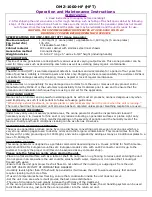
- 35 -
1
1
1
1
1
-8.
Remote controller
1
1
1
1
1
-8.1. Installing procedures
(1) Select an installing position for the remote controller (switch box).
Be sure to observe the following precautions.
B-1. To lead the remote controller cord from the back of the controller:
B-2. To run the remote controller cord through the upper portion:
1
Pull out the sensor, and remove the sensor fixture.
2
Connect the inlet duct.
3
Drill a sensor hole (ø12.5 dia.) on the side on the duct.
4
Assemble the sensor and fixiture.
•
When pulling out the sensor, do not pull it by the lead wire. Doing so may result
in wire breakage.
•
Before connecting the inlet duct, make sure that the sensor and its fixture are
removed.
•
The sensor removed in step
1
must be re-installed in the position specified in
the drawing. Installation of the sensor in an incorrect position may result in
malfuction.
•
Mount holes for outlet duct flange and inlet duct.
B
C
A
H
I
E
G
D
F
E
A
34
45
98
25
60
20
1000
PEH-7,8 1102
PEH-10 1302
PEH-7,8 31
PEH-10 66
PEH-7,8 120
PEH-10 220
250
380
[Fig.
1
1
1
1
1
-7.0.3]
A
Inlet duct flange
B
PEH-7, 8: 8
×
130pitch = 1040
PEH-10: 9
×
130pitch = 1170
C
PEH-7, 8: 24-ø3 holes (Inlet duct mount holes)
PEH-10: 26-ø3 holes (Inlet duct mount holes)
D
Top of the unit
E
Outlet duct flange
F
7
×
130pitch=910
G
22-ø3 holes(Outlet duct mount holes)
H
2
×
130pitch=260
I
2
×
100pitch=200
30
46
30
30
120
83.5
C
A
B
D
(1)
[Fig.
1
1
1
1
1
-8.1.1] (1)
A
Remote controller pro-
file
B
Required clearances
surrounding the re-
mote controller
C
Temperature sensor
D
Installation pitch
1
The temperature sensors are located on both remote controller and indoor
unit. To use the temperature sensor on the remote controller, mainly use the
remote controller for temperature setting or room temperature detection. In-
stall the remote controller in such an area that can detect average room tem-
peratures, free of direct sunlight, airflow from the air conditioner, and other
such heating source.
2
In either case when the remote controller is installed in the switch box or on the
wall, provide the clearances indicated in the diagram. (When the schedule timer
is used in combination, also refer to the installation manual supplied with the
schedule timer.)
Note:
Check that there is no electric wire left close to the remote controller sensor.
If any electric wire is near the sensor, the remote controller may fail to detect
a correct room temperature.
3
Procure the following parts locally:
Switch box for two pieces
Thin copper conduit tube
Lock nuts and bushings
(2) Seal the service entrance for the remote controller cord with putty to
prevent possible invasion of dew drops, water, cockroaches or worms.
<A> For installation in the switch box:
•
When the remote controller is installed in the switch box, seal the junction
between the switch box and the conduit tube with putty.
<B> For direct installation on the wall select one of the following:
•
Prepare a hole through the wall to pass the remote controller cord (in order to
run the remote controller cord from the back), then seal the hole with putty.
•
Run the remote controller cord through the cut-out upper case, then seal the
cut-out notch with putty similarly as above.
(3) Install the lower case in the switch box or on the wall.
C
Wall
D
Conduit
E
Lock nut
F
Bushing
G
Switch box
H
Remote controller cord
I
Seal with putty.
F
H
C
D
E
G
I
I
B-1.
B-2.
I
<A> For installation in the switch box:
<B> For direct installation on the wall
select one of the following:
[Fig.
1
1
1
1
1
-8.1.1] (2)
Caution:
Do not over-tighten the screws as it may deform or break the lower case.
Note:
•
Select a flat place for installation.
•
Be sure to use two or more locations for securing of the remote control-
ler in the switch box or on the wall.
C
Switch box for two pieces
D
Remote controller cord
E
Cross-recessed, pan-head screw
G
Seal the remote controller cord service entrance with putty
H
Wood screw
H
D
E
D
C
G
<A>
For installation in the switch box
<B> For direct installation on the wall
[Fig.
1
1
1
1
1
-8.1.1] (3)
Summary of Contents for PEH series
Page 2: ......
















































